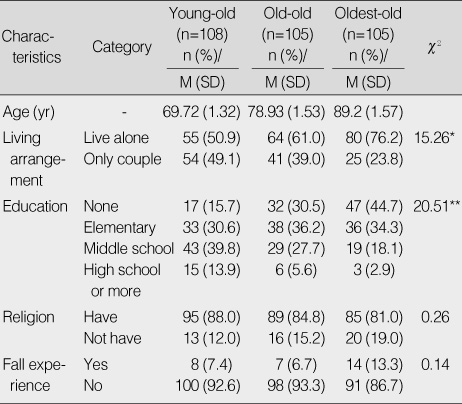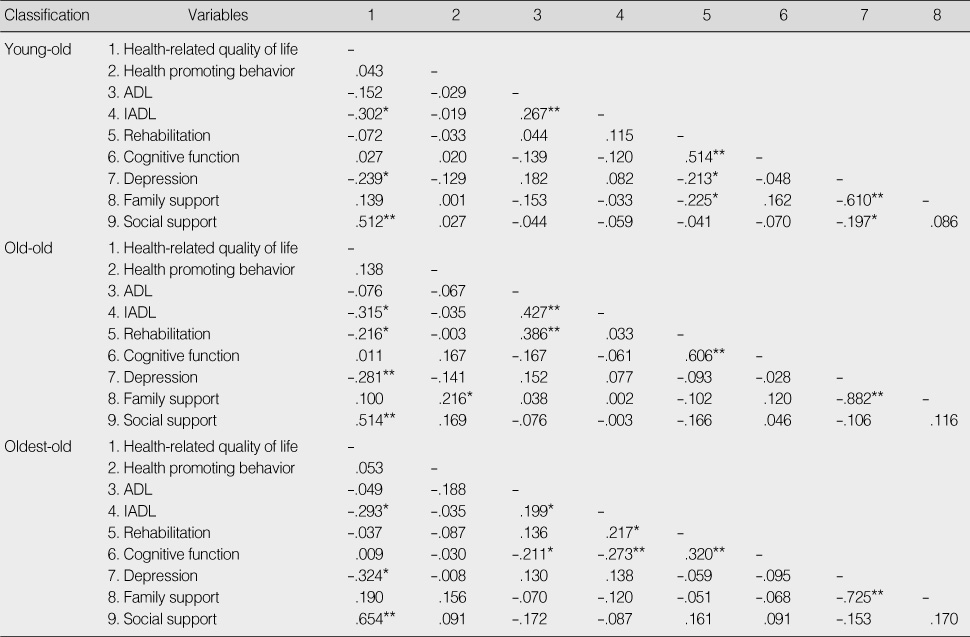Articles
- Page Path
- HOME > J Korean Acad Nurs > Volume 40(3); 2010 > Article
-
Original Article
- Factors Affecting the Health-related Quality of Life According to Age in Vulnerable Aged Men
- Eun Young Jeon, Yeon Hee Choi
-
Journal of Korean Academy of Nursing 2010;40(3):400-410.
DOI: https://doi.org/10.4040/jkan.2010.40.3.400
Published online: June 30, 2010
1Professor, Department of Nursing, Daegu Haanny University, Daegu, Korea.
2Professor, College of Nursing, Kyungpook National University, Daegu, Korea.
- Address reprint requests to: Choi, Yeon Hee. College of Nursing, Kyungpook National University, 101 Dongin-dong, Jung-gu, Daegu 700-422, Korea. Tel: 82-53-420-4926, Fax: 82-53-421-2758, yeonhee@knu.ac.kr
Copyright © 2010 Korean Society of Nursing Science
Abstract
-
Purpose
- The purpose of this study was to investigate the factors that influenced the health-related quality of life of young-old (65-74 yr) men, old-old (75-84 yr) men, and oldest-old (85 yr or above) men in vulnerable aged received home care from public health center.
-
Methods
- The participants for this study were 318 aged Korean men living in D city. The data was collected from August to October, 2009 using structured questionnaires. Chi-square, One way ANOVA, Duncan test, Pearson's Correlation Coefficient and multiple regression with the SPSS WIN 14.0 program were used to analyze the data.
-
Results
- There were statistically significant differences among young-old, old-old, and oldest-old men regarding the health-related quality of life, health promoting behavior, IADL (Instrumental Activities of Daily Living), rehabilitation, depression, and social support. The model including variables related to physical, psychological, and social aspects of life, explained variance of the health-related quality of life of aged men differently, such as 39.6% of young-old, 35.4% of old-old, and 47.0% of oldest-old. Finally, IADL and social support were predictors in explaining the level of health-related quality of life among vulnerable old men regardless of age.
-
Conclusion
- Based on the findings of the study, nursing interventions should be developed to improve health-related quality of life of vulnerable aged men according to age differences.
- 1. Belloc NB, Breslow L. Relation of physical health and health practice. Preventive Medicine. 1972;1:409–421.ArticlePubMed
- 2. Bowling A, Banister D, Sutton S, Evans O, Windsor J. A multidimensional model of the quality of life older age. Aging & Mental Health. 2002;6:355–371.Article
- 3. Cha SH, Han KH, Lee JH. Relationship between self-rated health and physical, mental social health: Differences among three aged group. Journal of the Korean Gerontological Society. 2002;22:173–190.
- 4. Choi YH. A study on depression, sleep and fatigue in younger and older elders. Journal of Korean Academy of Community Health Nursing. 2007;18:223–231.
- 5. Chung HJ, Kim TH, Lee DS. Related variables of health-related quality of life of aged women living alone in Chonbuk-do Province. Journal of the Korean Gerontological Society. 2000;20:49–70.
- 6. Cohen J. Statistical power analysis for the behavioral sciences. 1988;NJ, Lawrence Erlbaum Associates.
- 7. Ferruci LH, Eijk JT, Guralnik JM. Exploring the effect of depression on physical disability: Longitudinal evidence from the established populations or epidemiologic studies of the aged. American Journal of Public Health. 1999;89:1346–1352.PubMedPMC
- 8. Grundy E, Bowling A. Enhancing the quality of extended life years: Identification of the oldest old with a very good and very poor quality of life. Aging & Mental Health. 1999;3:199–212.Article
- 9. Hilleras P, Jorm AF, Herliltz A, Winbald B. Health-related quality of life among the very old: A survey on a cognitively intact sample aged 90 years or above. International Journal of Aging and Human Development. 2001;52:71–90.PubMed
- 10. Hwang MH, Doh BN. A study of perceived health status, social support and self care agency of the aged. Journal of Kyungpook Nursing Science. 2000;4:43–58.
- 11. Jang SA. The effects of social support on life satisfaction in the institutionalized aged. 1997;Seoul, Seoul National University. Unpublished master's thesis.
- 12. Jeon KS, Lee HK, Hong BK, Jang SR. Community health promotion program for vulnerable women. Journal of Korean Society for Health Education and Promotion. 2007;24:99–118.
- 13. Kang HS. An experimental study of the effects of reinforcement education for rehabilitation on hemiplegia patients' self-care activities. 1985;Seoul, Yonsei University. Unpublished doctoral dissertation.
- 14. Kim KB, Lee KH. The correlation among health status, burden and quality of life of the adult stroke patient's family and the aged stroke patient's family. Journal of Korean Academy of Adult Nursing. 2001;13:262–276.
- 15. Kim ML. The study of comparing the factors of affecting on the quality of life for young-old women and old-old women. Korean Journal of Social Welfare. 2006;58:197–222.
- 16. Kwon YC, Park JH. Standardization of Korean version of the Mini-Mental State Examination for use in the aged. Part II Diagnostic validity. Journal of the Korean Neurological Association. 1989;28:125–135.
- 17. Lawton MP, Brody EM. Assessment of older people: Self-maintaining and instrumental activities of daily living. The Gerontologist. 1969;9:179–186.ArticlePubMed
- 18. Lee BY, Jo HS, Lee HJ, Yoo SH. Health promotion priorities of older adults in a rural community. Journal of Korean Community Nursing. 2008;19:57–65.
- 19. Lee YJ, Kim TH. A Study on the buffering effect of social support on the stress of the aged who lives alone. Journal of the Korean Gerontological Society. 1999;19:79–93.
- 20. Ministry for Health, Welfare and Family Affairs. Statistical yearbook of health and welfare 2007. 2008;Seoul, Author.
- 21. National Health Insurance Corporation. Manual of grade-judgment for long-term care insurance. 2008;Seoul, Author.
- 22. Park HS, Lee KJ. A study on the health behaviors, physical function, and health-related quality of life for aged women. Korean Journal of Women Health Nursing. 2007;13:115–122.
- 23. Park JS. The effects of an aged health promotion program on health promotion lifestyles, health status and quality of lifein the aged. Journal of Korean Academy of Nursing. 2004;34:1194–1204.PubMed
- 24. Park SY. The relationship among family support, powerless and depression in the aged patient. Journal of Korean Academy of Adult Nursing. 1999;11:425–435.
- 25. Smith J, Borchelt M, Maier H, Jopp D. Health and well-being in the young old and oldest old. Journal of Social Issues. 2002;58:715–732.Article
- 26. Sung KW. Cognitive function, depression and self-esteem in the aged. The Journal of Nurses Academic Society. 1997;27:36–48.
- 27. Ware JE. The status of health assessment 1994. Annual Review of Public Health. 1995;25:327–354.
- 28. Won CW, Yang KY, Rho YG, Kim SY, Lee E, Yoon JL, et al. The Development of Korean Activities of Daily Living (K-ADL) and Korean Instrumental Activities of Daily Living (K-IADL) Scale. Journal of the Korean Geriatrics Society. 2002;6:107–120.
- 29. Yang SM. Factors influencing sense of mastery of elders in rural areas. 2005;Seoul, Kyunghee University. Unpublished master's thesis.
- 30. Yesavage J, Brink T, Rose T, Lum O, Huang V, Adey M, et al. Development and validation of a geriatric depression screening scale: A preliminary report. Journal of Psychiatric Research. 1982;83:290–299.
REFERENCES
Figure & Data
REFERENCES
Citations

- Influence of cognitive function and social support on health-related quality of life of elderly men in partial medically underserved rural areas: A cross-sectional study
Min Hye Hwang, Hye Kyung Lee
Journal of Korean Gerontological Nursing.2023; 25(2): 163. CrossRef - Effects of healthcare interventions on psychosocial factors of patients with multimorbidity: A systematic review and meta-analysis
Hyun-Ju Lee, Misoon Lee, Jae-Hyun Ha, Yeongsuk Lee, Jungmi Yun
Archives of Gerontology and Geriatrics.2020; 91: 104241. CrossRef - Aging Liver: Can Exercise be a Better Way to Delay the Process than Nutritional and Pharmacological Intervention? Focus on Lipid Metabolism
Hao Su, Dongsen Liu, Jia Shao, Yinuo Li, Xiaoxia Wang, Qi Gao
Current Pharmaceutical Design.2020; 26(39): 4982. CrossRef - The association between elderly people’s sedentary behaviors and their health-related quality of life: focusing on comparing the young-old and the old-old
Yujeong Kim, Eunmi Lee
Health and Quality of Life Outcomes.2019;[Epub] CrossRef - The effects of medication adherence and health literacy on health‐related quality of life in older people with hypertension
Nam Hee Park, Mi Sook Song, So Young Shin, Ji‐hye Jeong, Hyo Young Lee
International Journal of Older People Nursing.2018;[Epub] CrossRef - The Effects of Health Behavior and Health Status on Heath-related Quality of Life in Older People: Gender Analysis by using the 2012 Korea Health Panel Data
Min-Jeong Park, So Eun Choi
Journal of Korean Academy of Community Health Nursing.2017; 28(2): 118. CrossRef - An Observational Study on the Factors of Successful Aging in a Sample of Nonagenarian Patients in a Rehabilitation Hospital Complex
Maria Elena Boero, Alessandra De Francesco, Paola Vizzuso, Stefania Dessì
Journal of Population Ageing.2017; 10(4): 403. CrossRef - A Path Analysis of Factors Influencing Health-related Quality of Life among Male Adults
Bo-Kyoung Cha
Journal of Korean Academy of Community Health Nursing.2016; 27(4): 399. CrossRef - The Risk Factors of Suicidal Ideation by Age Groups among the Elderly in Korea
Eun Kyung Kim
Korean Journal of Health Promotion.2015; 15(2): 54. CrossRef - Prediction Model for Health-Related Quality of Life of Elderly with Chronic Diseases using Machine Learning Techniques
Soo-Kyoung Lee, Youn-Jung Son, Jeongeun Kim, Hong-Gee Kim, Jae-Il Lee, Bo-Yeong Kang, Hyeon-Sung Cho, Sungin Lee
Healthcare Informatics Research.2014; 20(2): 125. CrossRef - Factors associated with Health-related Quality of Life in Vulnerable Elderly Women
Gyeyoung Shin, Eun Kyung Kim
Journal of Korean Public Health Nursing.2014; 28(3): 419. CrossRef - Gender Difference in Factors Related to Depression in Vulnerable Elderly
Eun-Kyung Kim
The Korean Journal of Health Service Management.2014; 8(3): 169. CrossRef - The Relationships between Social Determinants of Health and Health-related Quality of Life among the Community-dwelling Elderly
Junghee Kim, Hyeonkyeong Lee, Chung Yul Lee, Eunhee Cho
Journal of Korean Academy of Community Health Nursing.2014; 25(4): 237. CrossRef - Clinical Outcomes and Quality of Life of Home Health Care Patients
Suk Jung Han, Hyun Kyung Kim, Judith Storfjell, Mi Ja Kim
Asian Nursing Research.2013; 7(2): 53. CrossRef - Factors Influencing the Health-Related Quality of Life by Age among Vulnerable Elderly Women
Yun-Hee Kim
Journal of the Korea Academia-Industrial cooperation Society.2013; 14(3): 1342. CrossRef - Multigroup analysis on the Multicultural couples’ Quality of Life in Korea
장윤경
The Korean Governance Review.2013; 20(1): 55. CrossRef - Effect of Perceived Health Status, Sleep and Depression on Quality of Life of Elderly School Participants
Koung-Oh Chang, Do-Yi Bae, Su-Gin Park
Journal of muscle and joint health.2012; 19(3): 329. CrossRef
General Characteristics (N=318)
*p<.05; **p<.01.
The Level of Health-related Quality of life and related Variables (N=318)
**p<.01; ***p<.001.
ADL=Activities of Daily Living; IADL=Instrumental Activities of Daily Living.
Correlations of related Variables with Health-related quality of life (N=318)
*p<.05; **p<.01.
ADL=Activities of Daily Living; IADL=Instrumental Activities of Daily Living.
The Predictors of Health-related quality of life (N=318)
*p<.05; **p<.01; ***p<.001.
ADL=Activities of Daily Living; IADL=Instrumental Activities of Daily Living.
*
** ADL=Activities of Daily Living; IADL=Instrumental Activities of Daily Living.
* ADL=Activities of Daily Living; IADL=Instrumental Activities of Daily Living.
* ADL=Activities of Daily Living; IADL=Instrumental Activities of Daily Living.
 KSNS
KSNS
 E-SUBMISSION
E-SUBMISSION




 Cite
Cite

